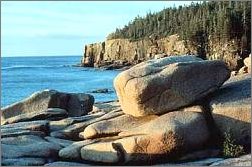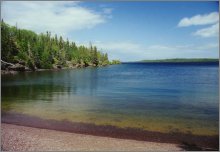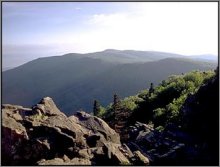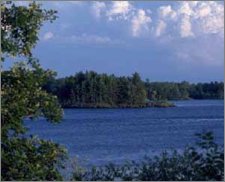The world's first national park was created back in 1872 to provide a "pleasuring ground for the benefit and enjoyment of the people in order to protect for all time this outstanding natural area." And today, millions of people have enjoyed this park named Yellowstone.
 |
1. Acadia National Park
Bar Harbor, Maine
At Arcadia you can explore 47,000 acres of Maine's coastline, woodlands, lakes, ponds and granite-domed mountains. Native American Indians are thought to have lived in Acadia some 6,000 years ago. And, as the first national park to be created east of the Mississippi, Acadia has been a favorite stomping ground for the affluent since the turn of the century.
Acadia has incredibly diverse terrain. You can watch a sunrise over the bay, hike to the top of a mountain, or walk around the more secluded trails. If you're in to biking, Acadia has over 40 miles of carriage roads that span the hillside.
 |
2. Isle Royale National Park
Houghton, Michigan
Isle Royale, located on the shoreline of Lake Superior, is so secluded that you can only get there by boat or float plane. It's also a United States Biosphere Reserve, which are meant "to promote and demonstrate a balanced relationship between humans and the biosphere," and must "encompass a mosaic of ecological systems."
With 165 miles of hiking trails and 36 campgrounds, Isle Royale is an ideal location for experienced backpackers, fishermen, boaters and campers. In all, it encompasses 850 square miles, and 99 percent of the land is federally designated wildlife. History buffs can take in historic lighthouses, shipwrecks and ancient copper mining sites, while nature lovers can take in wildlife.
 |
3. Kings Canyon National Park
Southern Sierra Nevada in Tulare and Fresno counties, California
In Kings Canyon, and its next-door-neighbor park Sequoia, you can see giant mountains and trees alongside deep canyons. These parks have oak-tree-dotted foothills, sequoia groves and marble caverns, but most of the parks are composed of high-alpine wilderness.
Visitors can enjoy tours in the foothills, sequoia groves and high-country, river activities and horseback riding in the summer, and cross-country skiing and snowshoeing in the winter.
 |
4. Shenandoah National Park
Blue Ridge Mountains near Luray, Virginia
Shenandoah National Park is home to diverse wildlife, including deer, black bears and wild turkeys, an oak-hickory forest, waterfalls, deep canyons and mountain peaks. It has over 500 miles of trails, 101 of which are part of the Appalachian Trail, a national hiking tail that spans from Georgia to Maine.
Shenandoah has hiking, picnicking, camping (either in a developed campground or the backcountry with a permit), and fishing. Or, explore the trails and see if you can find Shenandoah's apple trees, wild flowers, stone foundations and cemeteries.
 |
5. Voyageurs National Park
International Falls, Kabetogama, Ash River, and Crane Lake, Minnesota
Voyageurs has some of the oldest exposed rock formations in the world, shaped by at least four periods of glaciation. This rugged terrain is part of the southern part of the Canadian Shield, and most of its shoreline is only accessible by boat.
Along with rock formations, at Voyageurs you can see bogs, beaver ponds, swamps, islands, migratory birds, many lakes and the north woods, a rich forest ecosystem. The park got its name from the French-Canadian canoe-men of the same name, who were known to travel the Great Lakes in canoes made of birch bark. This park is ideal for water sports, fishing, camping, and exploring the north woods.
Click to Suscribe my post
Tidak ada komentar:
Posting Komentar